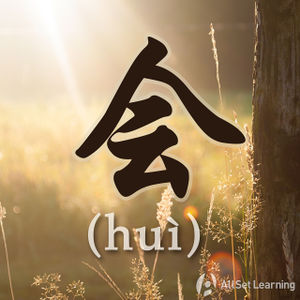Difference between revisions of "Expressing a learned skill with "hui""
| Line 9: | Line 9: | ||
<div class="jiegou"> | <div class="jiegou"> | ||
| − | Subj. + 会 + Verb + | + | Subj. + 会 + Verb + Object |
</div> | </div> | ||
| Line 35: | Line 35: | ||
<div class="jiegou"> | <div class="jiegou"> | ||
| − | Subj. + 不 + 会 + Verb + | + | Subj. + 不 + 会 + Verb + Object |
</div> | </div> | ||
Revision as of 09:58, 17 October 2016
-
Level
-
Similar to
-
Used for
-
Keywords
The word 会 (huì) can be used to express an ability that has been learned (a skill). In this case 会 (huì) is an auxiliary verb.
Contents
Structure
The basic structure for 会 (huì) is:
Subj. + 会 + Verb + Object
This structure is the easiest way to express all kinds of skills, from languages, to sports, to skills in daily life such as cooking, and driving.
Examples
- 他 会 说 中文。He can speak Chinese.
- 我 会 写 汉字。I can write Chinese characters.
- 你 会 做 饭 吗?Can you cook food?
- 狗 会 唱 歌 吗?Can dogs sing?
- 爸爸 会 开车。 Dad can drive.
Negating 会 sentences
Structure
会 (huì) sentences are negated with 不 (bù), which is inserted in front of 会 (huì):
Subj. + 不 + 会 + Verb + Object
Again, this is the simplest way to express the lack of a learned ability. So while "can't" is a natural translation for "不会" (bù huì) in English, "don't know how to" is equally correct (and perhaps more helpful).
Also, due to a tone change rule for "不" (bù), the phrase "不会" (bù huì) is actually read as "bú huì".
Examples
- 我 不会 说 英文。I can't speak English.
- 妈妈 不会 做 中国 菜。Mom can't cook Chinese food.
- 你 不会 游泳 吗?You can't swim?
- 我 奶奶 不会 用 电脑。My grandmother can't use a computer.
- 你 不会 开车 吗?You can't drive a car?
Note that if we say 我不能说中文 (wǒ bù néng shuō Zhōngwén), the speaker is saying that he can't speak Chinese for some reason other than his own ability, perhaps because speaking Chinese in English class is forbidden.
See also
Sources and further reading
- Integrated Chinese: Level 1, Part 1 (3rd ed) (pp. 219-20) →buy
- New Practical Chinese Reader 1 (新实用汉语课本1) (pp. 160-1, 200) →buy
- New Practical Chinese Reader 1 (新实用汉语课本1)(2nd ed) (pp. 185-7, 228) →buy



